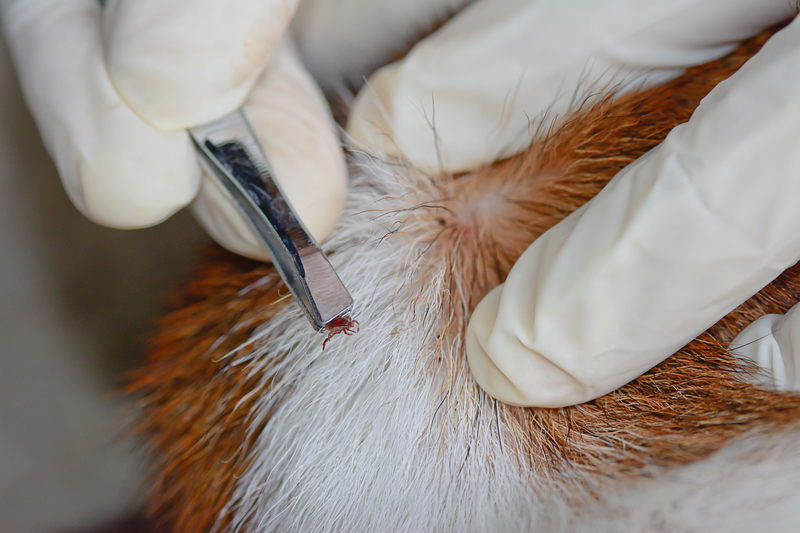At some point in our dog's life, we've all listened to the vet tell us about the topical options we have to fight ticks and Lyme disease on our dogs. It's easy to jump to conclusions thinking that a chemical is the only way to properly fight those pests. After all, our dogs are family and we would want to do whatever a doctor recommended to prevent any future health problems.
Sometimes, however, our vigilance and regular vet check-ups are the best ways to fight Lyme disease for our furbabies. The more you're informed, the better your dog's health will be!
Facts About Lyme Disease Every Dog Parent Should Know
Lyme disease is caused by Borrelia burgdorferi bacteria, which is carried by certain types of ticks.
And just because a tick carrying the bacteria attached to your dog doesn't mean he will get Lyme disease, as only a percentage of dogs exposed become infected.
And in fact, many dogs infected with B. burgdorferi show no symptoms at all, and the bacteria is only discovered during routine blood tests, which is why I recommend checking for infection at least annually.
Common symptoms of Lyme disease include:
- Fever
- Lameness that shifts from leg to leg
- Hot, painful, swollen lymph nodes
- Lethargy
- Joint swelling
- Loss of appetite
Rarely, an infected dog develops severe, progressive kidney disease. Kidney failure can be life-threatening, so if your dog has tested positive for Lyme, it's a good idea to schedule regular blood and urine tests to monitor her kidney function.
Lyme Disease Causes Few or No Symptoms in Most Dogs
About 95 percent of dogs that test positive for Lyme disease live in just a dozen U.S. states. These are states in which Lyme disease is endemic (pervasive) — states with heavy infestations of deer ticks.
The bottom line is that while exposure to B. burgdorferi in dogs is common, Lyme disease is not. In fact, in some areas of New England, the vast majority of healthy dogs are Lyme-positive. These are not sick dogs, but dogs who've been exposed to the bacteria that causes the disease.
Lyme Disease Prevention Tips
- In the spring, summer and fall, avoid tick-infested areas.
- If you live where Lyme disease is endemic or you inadvertently wind up in a tick-infested area, check your dog for ticks twice each day. Look over her entire body, including hidden crevices.
- Use tick repellents. It's important to investigate the risks and benefits of any medication before you give it to your pet, as most have side effects. Combining natural tick repellents, including topical diatomaceous earth, herbal sprays and collars (herbal, amber and Shoo!Tags may all be beneficial), may help reduce the number of chemical applications your vet recommends.
- There is a vaccine available for Lyme disease, but I don't recommend it for a couple of reasons. Number one, this vaccine is known to send the immune system into overdrive, which can trigger a number of serious secondary reactions including autoimmune disease. Number two, many pet parents believe the vaccine will prevent ticks from attaching to their dog. This isn't the case — you will still need to apply a topical tick repellent to your pet.
Should I Be Worried About My Own Dog?
Since up to 95 percent of dogs exposed to Lyme disease never get sick from it, chances are if your dog is exposed and healthy, he won't either. But if he winds up one of the unlucky 5 to 10 percent that becomes ill with Lyme symptoms, ask your veterinarian to run a confirming QC6 test if the SNAP-4Dx blood test is positive.
The QC6 test will confirm your dog is actually positive and will also allow your vet to check to insure treatment was successful. He or she may also do a urinalysis.
Dogs can acquire Lyme disease and tick co-infections more than once, so continuing to test for re-infection is necessary, even after your dog has been successfully treated for the disease.
Hopefully, that helps to alleviate some of your Lyme disease jitters! Basically, you shouldn't let those tiny ticks ruin any future adventures with your dog, especially as the gorgeous days of spring and summer arrive.
Now that you know what to look for with Lyme disease, you and your dog can get back to exploring! For more on Lyme disease and how else you can help Fido, visit Healthy Pets.









